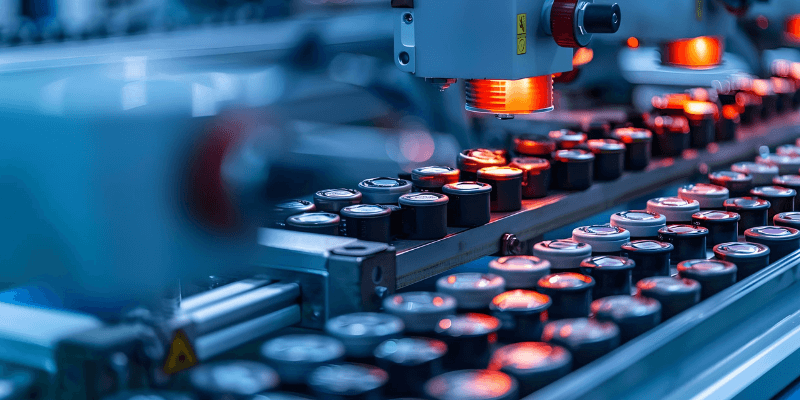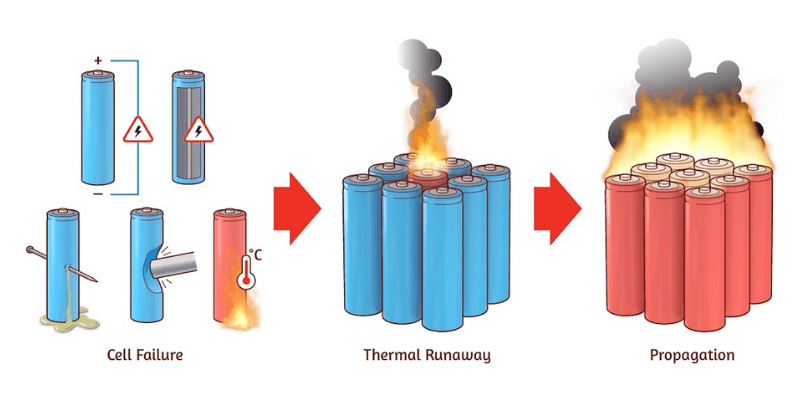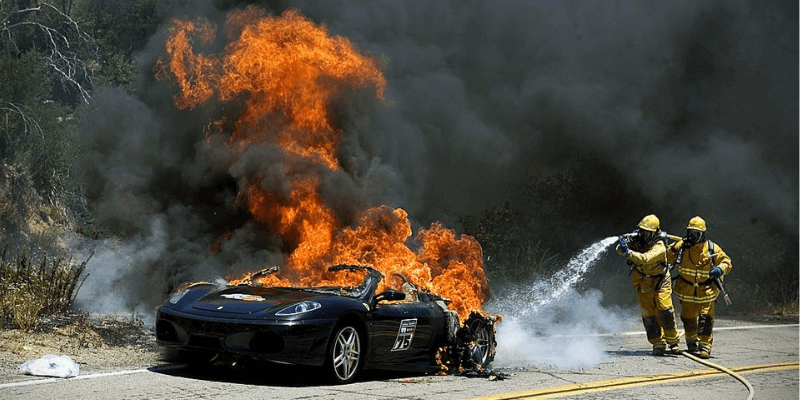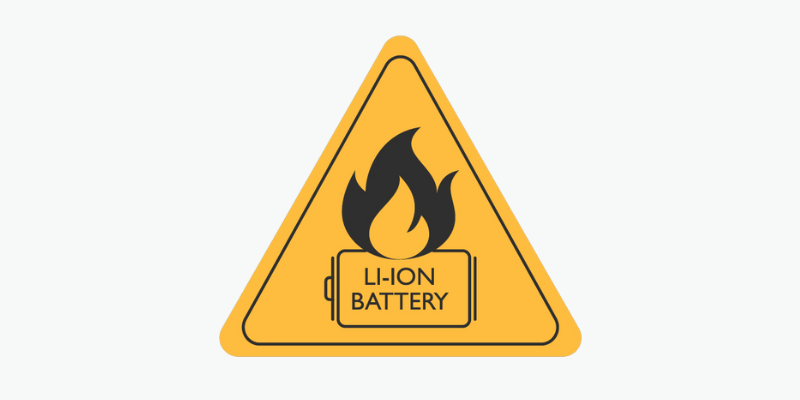Bezpečnosť lítiové batérie bol pod intenzívnou kontrolou a kreslil paralely s historickými rizikami skladovania energie, ako sú výbuchy parného motora a skoré benzínové kontroverzie. Zatiaľ čo lítium-iónová technológia je vo všeobecnosti bezpečná, príležitostné zlyhania, ako napríklad stiahnutie Sony z roku 2006 zo šiestich miliónov balíčkov, zdôrazňujú potenciálne riziká.
Cieľom výrobcov batérií je znížiť kovové častice, ktoré môžu spustiť skraty, a to napriek výzvam pri udržiavaní absolútnej čistoty v čistenie batérií. Bunky s ultra tenkými separatormi (24 um alebo menej) sú náchylnejšie na nečistoty ako staršie návrhy. Keď sa môžu zapáliť, vyvinuli sa nové bezpečnostné normy UL, ktoré už nevyžadujú testy penetrácie na prijatie lítiových batérií.

Aby sa zaistila bezpečnosť pred prepustením, výrobcovia predmety vzoriek batérií dôkladného testovania, ktoré si vyžadujú milión vzoriek bez zlyhania v priebehu roka pred schválením kritických aplikácií, ako sú zdravotnícke pomôcky.
Keďže súčasná technológia Li-Ion sa blíži k limitom svojej energetickej kapacity, výrobcovia uprednostňujú zlepšenia bezpečnosti a dlhovekosti pred čistou kapacitou. Výzvy pretrvávajú s vnútornými skratkami, ktoré môžu premôcť opatrenia na vonkajšiu ochranu, o čom svedčí stiahnutie z roku 2006, ktoré spĺňali bezpečnostné požiadavky UL, ale stále zlyhali počas normálneho používania.
Battery failures fall into two categories: predictable design flaws and random events without clear design issues. A minor short can cause increased self-discharge with minimal heat buildup. However, an accumulation of metallic particles can lead to significant current flow and excessive heating, potentially causing tepelný útek, often described as “venting with flame.”
Moreover, uneven separators increase resistance and generate local heat spots that weaken the separator’s integrity. Most major Li-ion manufacturers x-ray each cell during quality control to detect anomalies like bent tabs or crushed jelly rolls – contributing to today’s battery safety standards that are typically upheld by recognized brands only.

Advancing Lithium-Ion Battery Safety: Key Considerations
Quality lithium-ion batteries are inherently safe when used correctly. However, numerous heat and fire incidents have been reported in consumer products with non-certified batteries, such as hoverboards. These issues have largely been resolved with certified Li-ion batteries in recent models.
Misuse, such as exposure to extreme conditions or overcharging, can lead to failures across all battery types, emphasizing the need for proper handling practices. Li-ion cells require careful management to prevent instability, including avoiding deep discharges and prolonged low voltage exposure. Heat and overcharging are primary stressors for Li-ion batteries, necessitating cautious storage practices like partial charging and protection from direct sunlight. Manufacturers bear responsibility for battery failures, underscoring their commitment to safety standards despite rare incidents in daily device usage.
Despite over a billion mobile devices in use daily, accidents remain rare – less than one failure per million for quality Li-ion cells compared to a 1 in 13,000 chance of being struck by lightning over a lifetime.
Industrial batteries used in power tools are typically more rugged than consumer models, but focus on power delivery rather than long runtimes. Power Cells are safer if abused compared to Energy Cells.
In recent years, concerns have highlighted risks associated with unfamiliar brand name Lithium-Ion (18650) cells often used for vaping; these may lack the quality assurance found in reputable brands. Fires from defective e-cigarette batteries have led to dangerous incidents, like an emergency landing of a WestJet flight due to an onboard fire caused by illegal battery transportation.
Regarding electric vehicles (EVs), statistics show they produce fewer fires per billion kilometers driven compared to internal combustion engine (ICE) vehicles: about two fires per billion kilometers for Tesla versus around 90 for ICE vehicles today, after over 400,000 ICE cars caught fire during the ’80s.

What to Do If a Battery Overheats or Catches Fire
During a Li-ion battery overheating incident, prompt action is vital. If the battery hisses or bulges, move the device to a non-flammable surface and consider relocating it outdoors. Simply disconnecting the battery may not be enough to prevent further issues.
For small Li-ion fires, use foam, CO2, dry chemicals, graphite powder, copper powder, or soda extinguishers. In airplane cabins, flight attendants may use water or soda to manage Li-ion fires due to the low lithium content in the batteries.
Cargo areas are equipped with fire suppression systems, such as Halon, to manage Li-ion fires alongside other flammable materials. New extinguishing methods like Aqueous Vermiculite Dispersion (AVD) and Extover® provide innovative ways to smother burning batteries; sand in fireproof containers can also effectively control burns.
In the case of EV fires, which can be more intense than those involving internal combustion engine vehicles, specific firefighting methods are required. Class D extinguishers are recommended for lithium-metal battery fires due to their reactivity with water.
As EV numbers increase, the need for evolving firefighting techniques, such as incorporating dividers between cells to prevent chain reactions during thermal runaway, becomes essential.

Effective Guidelines for Handling Li-ion Battery Fire
- In the event of a failing Li-ion battery, marked by hissing, bulging, and electrolyte leakage, immediate action is crucial to prevent potential hazards.
- Dousing a Li-ion fire with water or using a standard fire extinguisher is recommended to mitigate the risk of ignition of nearby combustible materials.
- When dealing with lithium-metal fires, it is essential to utilize a Class D fire extinguisher due to the reactive nature of lithium with water.
- In the absence of a Class D extinguisher, water can be used as an alternative to prevent the fire from spreading effectively.
- For optimal outcomes in extinguishing a Li-ion fire, various extinguishing agents such as foam, CO2, ABC dry chemical, graphite powder, copper powder, or soda can be employed, similar to standard combustible fire scenarios.
- In cases where a burning lithium-ion battery cannot be extinguished, allowing the pack to burn out in a controlled manner is a viable approach. It is important to monitor cell propagation, as each cell may burn at different rates when exposed to heat, and to safely dispose of seemingly burned-out packs by placing them outdoors for a period of time to minimize potential risks.

